Highlights. More history, more caches, and book burning memorial.
John and I headed for Checkpoint Charlie, while
leaving Katherine to have a chill out day.
We knew that the area was over commercialised
but were still keen to visit. It proved to be short and sweet. We arrived, took
photos, decided not to visit the museum which we had been warned against and
moved on to the Black Box area.
An armed confrontation between the Americans
and the Russians at Checkpoint Charlie occurred in 1961, escalating the
tensions between East and West. Since 2006, an open-air museum dedicated to
this subject has been located on the very spot. In 2012, the Black Box opened
on adjacent grounds, serving as a provisional exhibit until a Museum of the
Cold War is built on this historic location.
I checked and found most reviews suggested just
looking at the outside exhibits so we followed that advice. The outside did
detail a number of successful escapes over the wall. The comment was added that
the Stasi carefully analysed all successful escapes to attempt to close off
weak points.
We walked towards ‘the Topographie des Terrors’
which took us along part of the route the wall had followed. There were lots of
other wall based areas on the way. The one that caught our attention was the Trabi
museum. It seemed to display them and allow you to hire them or be driven in
them
Behind was a large tethered balloon. I had been
researching best Berlin views and this had come up. We had been too late for
the Reichstag and the TV tower reviews had indicated it can take a lot of time
so we might well have checked this one out to see if there were places as it
had good reviews. However, it was a bit windy and the balloon ascents were not
happening. The wind was a bonus for John as it was cutting the heat.
More than 1.3 million people visited the
"Topography of Terror" in 2017, making the documentation centre one
of the most frequently visited places of remembrance in Berlin. During the
"Third Reich" the headquarters of the Secret State Police, the SS and
the Reich Security Main Office were located at the site.
We spent a long time looking at the outside which documented
the time from 1933 when the Nazi Party took control in Germany.
At the request of the “Topography of Terror,”
the remaining 200 meters of the Wall in this area have been preserved with all
the traces of the destruction that occurred during the transitional period.
This fragment of the Wall was designated a historic monument in 1990 and was
fenced off for protection. The outside area we looked at ran parallel with this
piece of the wall.
We spent a long time viewing the replica
photos of the time, with information in both German and English, and quotes
from Goering’s diary. I overheard an explanation about the diary which sounded
plausible. He had tried to get work published prior to his rise to power
without success. When in a position of power, he got his secretary to type it
on expensive paper and triple-spaced. it was found after the war and someone spotted
the quality of the paper and hence it was saved. The quotes made chilling
reading. His entry of 18 April 1933 said “One year from now all of Germany will
belong to us”.
One moving quote came from the Berlin
correspondent for a French paper. ‘I also recall pictures and gestures that I
will never forget and no photographer captured; men and women looking away as
the brown uniforms marched past, and swiftly vanishing inside their homes.
People who found it hard to hide their anger, their helplessness, their pain or
their fear.
’ There was a map showing the huge number of official and unofficial
concentrations camps and places of interrogation and torture that existed in
1933/1934.
We then walked to Potsdamer Platz. In 1930 it
was one of the busiest squares in Europe. After the division of Berlin, the
British, Soviet and American sectors met here. After the Soviet area was sealed
off, it was part of no man’s land on the Eastern side and a wilderness on the
West. It is now back to being a busy square, but with signs about the Wall and
wall remnants. John finally had his first curry-wurst this trip in this area
before we caught a bus to the riverside.
We were heading for a boat trip, having done
some research but leaving the decision until the day. We went on one with good
recommendations and a live commentary. The guide was very helpful by first
saying in both German and English which side to look and then explaining. It
meant we knew what we should be looking at and then had the explanation
immediately after the German one. The guide also had a sense of humour so it
was a relaxed commentary.
We started by Berlin
Cathedral which is the short name for the Evangelical Supreme Parish and Collegiate
Church in Berlin. It was completed in 1905 and is Berlin's
largest and most important Protestant church. We were advised that the
views from the tower here are great, although we didn’t go up anywhere for
views today. It looked lovely from the river and we saw it from many angles as
we sat in the boat before it departed, and then went a short distance past it
as far as the lock, before turning.
We saw the rebuilding of the Schloss from the
back, which is just plain, with the other 3 sides to be a replica. Axel had
told us a bit about it and the guide added to this by telling us it is to be a
museum opening in about 2 years. Some exhibits are already being installed as
some will be too big to fit through the doors once the building is complete.
We went past the Nickoli Quarter and spotted a
few original buildings amongst the new ones that were part of the rebuild in the
1980s.
After our turn the boat sailed through the
parliamentary area and we had comments made about the number of buildings that
were full of staff for the parliament.
There are tunnels that link many to the
Reichstag. We were also shown the area where Angela Merkel lives.
We had wondered about the blue pipes we often
saw and were given the explanation. The area is marshy and these are used to
pump water out to stop the many wooden piles rotting.
We went under one of the few bridges not destroyed
in the war as well as others replaced since. We also went past the new central
train station which we were told is too small for the first class carriages to
be under cover, something that amuses people in Berlin. We had previously been
told that originally there were stations on 4 sides and you had to get through
town if you were wanting to use Berlin as a hub.
Some information repeated things that Axel had
told us. We also saw the pregnant oyster but were told it is also known as Jimmy
Carters’ smile, a name that made equal sense and links to it being give by the
USA. We also had the ‘beaches’ pointed out to us. We were told that any land
near water tended to be called a beach and certainly there were beach chairs,
but no sand.
After the boat trip we walked across the bridge
to the Humboldt University area. Opposite is the area where the books were
burned in 1933. There is now a most unusual memorial there created by the Israeli
artist Micha Ullman. It was inaugurated on May 20, 1995. Looking through a
glass plate you see a 5x5x5 meters room in the underground, with white walls
and empty shelves which offer space for 20,000 books – symbolizing this loss. I
knelt down to peer and asked John to give me a boost up. Another man kindly offered
his arm, but I said ‘thanks but that is what husbands are for’. He then asked
me what the significance was and I was pleased I knew, although I didn’t say I
knew because of the geocache page I had read. Yes, there was a cache there, and
well worth doing.
John was ready to go back while I wanted to do a few things on
the way, so we caught a bus that would take John home and drop me on the way.
The best laid plans and all…. There had been road works that had the bus
diverted as we came in but this time the bus stopped and we all had to get off.
So we walked for 5minutes to another bus stop and found we were going through a
road outside the British Embassy was blocked off for cars so that may have been
the reason.
We got on a new bus and were by the Tiergarten when the driver
pulled into the bus stop and there was a noise that sounded like he had hit the
kerb or something. Next he said the bus was ‘defect’ and we all had to get off
again. We thought waiting for the next might be an issue as our bus was full so
again did a walk to another bus stop. This took us past other embassies so was
a nice area. This bus did what we wanted so I got off near the Europa shopping
centre and John went back to the apartment.
The
Europa Centre is a shopping centre but I was there to see the clocks. One of
the major attractions is the "Clock of Flowing Time". The 13m high
clock stretches across three floors. The clock was designed and built by
Frenchmen Bernard Gitton in 1982. The time is shown with the help of coloured
liquid in 12 large and 30 small glass spheres.
The small spheres show the
minutes, the large spheres the hours. Each of small spheres fills within two
minutes, meaning that by the time all 30 have been filled a complete hour has
passed. Past hours remain visible by counting the number of large spheres,
which are filled. If 60 minutes are up so that 30 of the small spheres are
filled, then their contents flows into the corresponding large sphere which
represents the hour and the cycle starts again with the small spheres. After 12
hours, when the entire system is filled, it is emptied. So the cycle can start
again. This can be seen every day at 1am and 1pm.
The
other clock, ‘the Berlin Clock’, was designed by Dieter Binninger in 1975. It
is 7 meters high. At this clock the time is shown with lit and coloured
segments. The clock is read from the top row to the bottom. The top row of four
red fields denote five full hours each, alongside the second row, also of four
red fields, which denote one full hour each, displaying the hour value in
24-hour format. The third row consists of eleven yellow-and-red fields, which
denote five full minutes each (the red ones also denoting 15, 30 and 45 minutes
past), and the bottom row has another four yellow fields, which mark one full
minute each.
The round yellow light on top blinks to denote even- (when lit) or
odd-numbered (when unlit) seconds.
I
then went to the Kaiser Wilhelm Memorial Church. The original church on the
site was built in the 1890s. It was badly damaged in a bombing raid in 1943.
The present building, which consists of a church with an attached foyer and a
separate belfry with
an attached chapel, was built between 1959 and 1963. The damaged spire of the
old church has been retained and its ground floor has been made into a memorial
hall. The Memorial Church today is a famous landmark of western Berlin, and is
nicknamed by Berliners "der hohle Zahn", meaning "the hollow
tooth". It reminded me of Coventry Cathedral.
Finally,
I went by another bus to a spot with a virtual cache that made me think of Ted.
It was a statue of 2 motorcycles and the area had been the site of a test track
in the 1940’s.
Back
at the apartment, John had decided to stay in, eat left overs and watch
Football while Katherine and I went out for a meal. We just wandered up the
street until we found a place that was reasonably busy but had space and
suitable food. I am sure the fact they also had a choice of 100 beers did not
influence Katherine’s choice. It also had the football on, which we were able
to ignore.

 Berlin, Berlin, Germany
Berlin, Berlin, Germany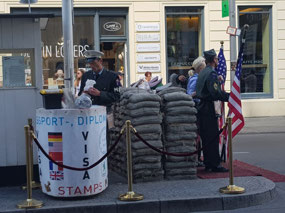

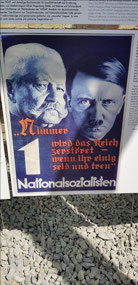
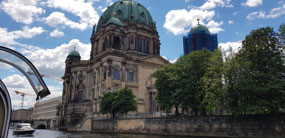
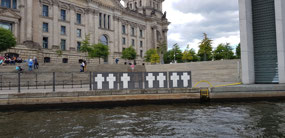
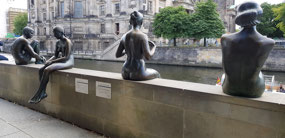
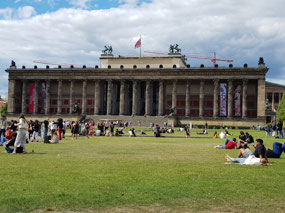
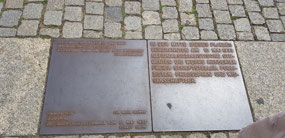
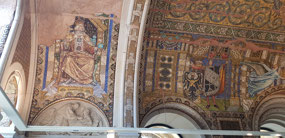
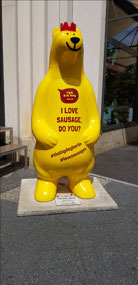








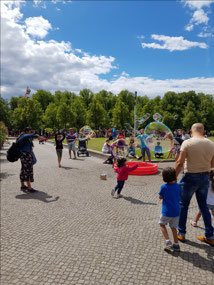
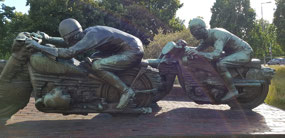
2025-05-22